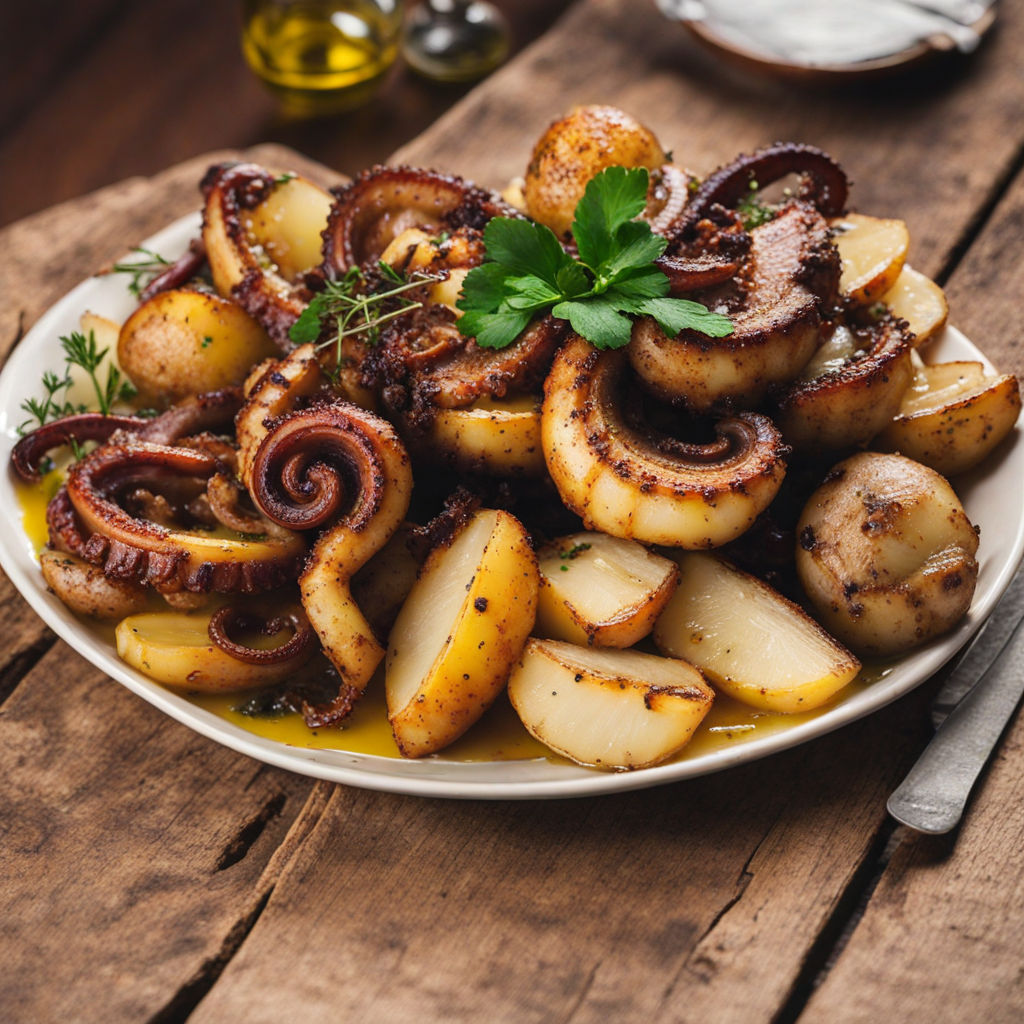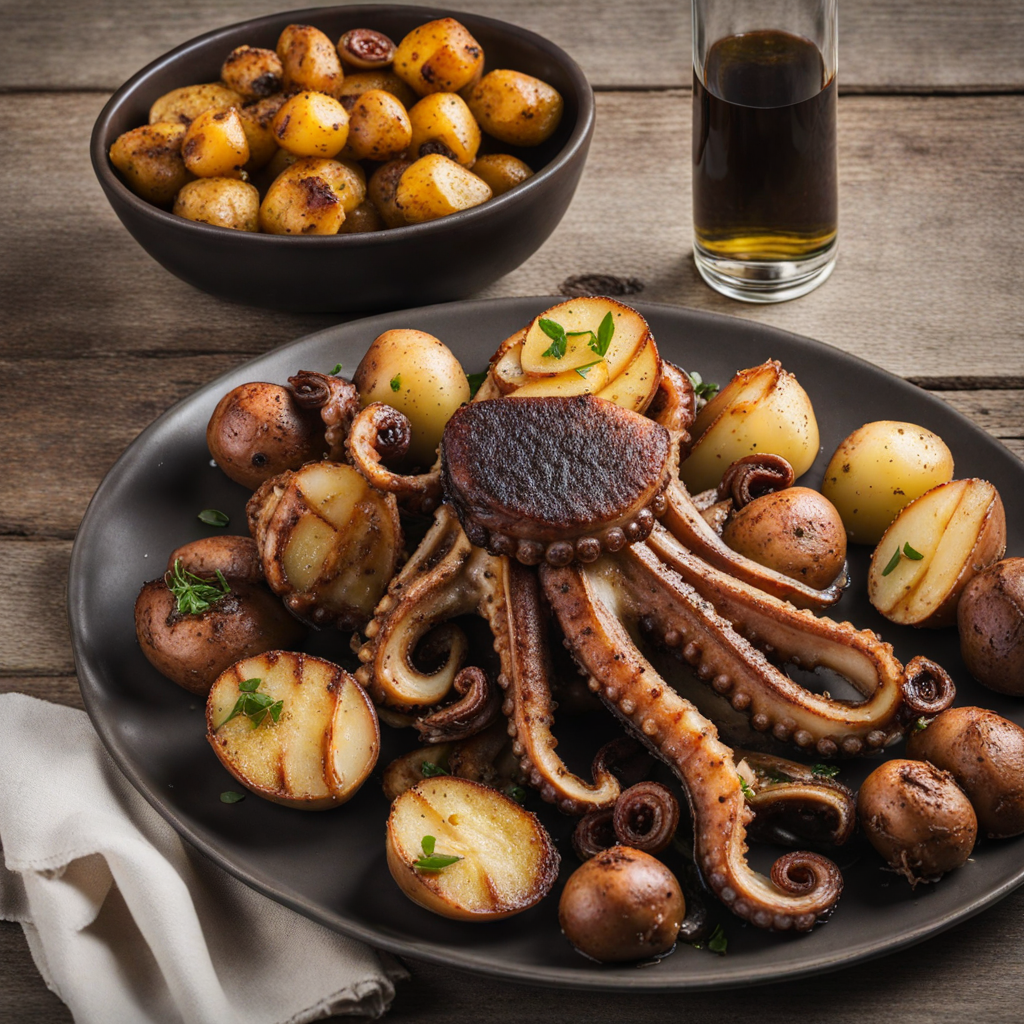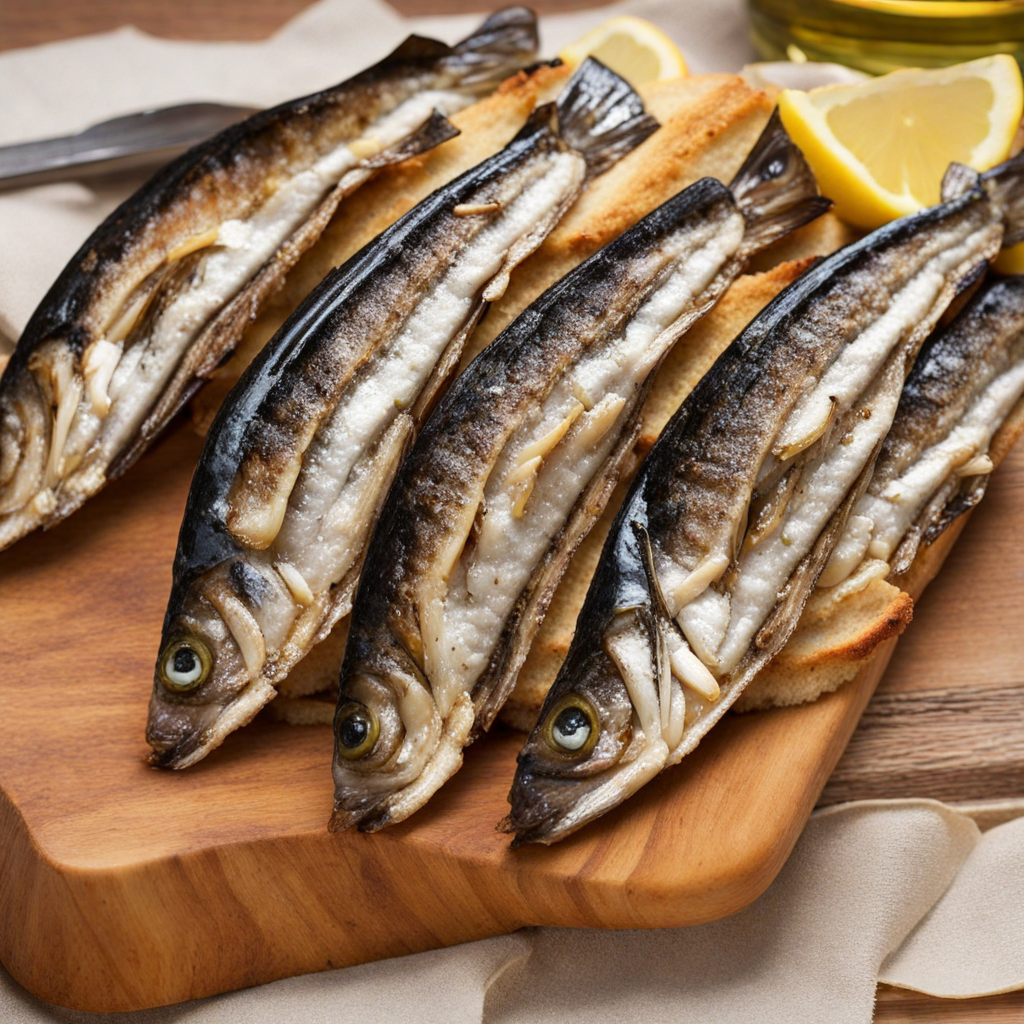Polvo à Lagareiro
Polvo à Lagareiro is a delightful Portuguese dish that showcases the exquisite flavors of octopus, a seafood staple in coastal cuisines. The dish features tender, perfectly cooked octopus that is often grilled or roasted to achieve a slightly charred exterior while maintaining a succulent and juicy interior. The octopus is typically seasoned with a mix of garlic, olive oil, and fresh herbs, infusing it with a robust flavor profile that is both savory and aromatic, giving it a unique character that speaks to the heart of Portuguese culinary tradition. One of the standout elements of Polvo à Lagareiro is the generous drizzle of quality extra virgin olive oil, which not only enhances the taste but also adds a luscious richness to the dish. This oil is often complemented by the vibrant taste of fresh parsley and a hint of lemon, creating a harmonious balance that brightens the dish. The octopus is usually served alongside potatoes, which are often boiled or roasted and absorb the delightful flavors of the olive oil and seasonings, making for a comforting and satisfying meal. This dish is not only a feast for the palate but also a visual delight, often presented with a sprinkle of paprika or fresh herbs, enhancing its appeal. Polvo à Lagareiro embodies the essence of Portuguese cuisine: simple yet bold flavors, high-quality ingredients, and a celebration of the sea. For those eager to explore new tastes, this dish is a true invitation to experience the rich culinary heritage of Portugal, offering a taste of both tradition and coastal charm.
How It Became This Dish
The Rich History of Polvo à Lagareiro: A Portuguese Culinary Delight Polvo à Lagareiro, or "Octopus à Lagareiro," is a traditional dish from Portugal that encapsulates the essence of Portuguese coastal cuisine. Known for its simplicity and rich flavor, this dish has deep roots in Portuguese culture and history, reflecting the country's maritime heritage and the importance of fresh, high-quality ingredients. Let us explore the origins, cultural significance, and development of this beloved dish over time. #### Origins of Polvo à Lagareiro The name "Lagareiro" derives from "lagar," which is a traditional wine press used in the production of olive oil and wine. This etymology hints at the dish's connection to the agricultural practices of the region, specifically in the Alentejo and the Algarve, where olive oil plays a pivotal role in the local cuisine. The dish primarily features octopus, a staple in Portuguese seafood gastronomy, highlighting the country's extensive coastline and longstanding fishing traditions. The origins of octopus as a food source can be traced back to ancient times. Archaeological findings suggest that octopus has been consumed since prehistoric times in the Mediterranean, where it was an essential part of the diet of coastal communities. In Portugal, octopus is not only a dietary staple but also a symbol of abundance and culinary creativity, particularly in regions where fishing is vital to the local economy. #### Cultural Significance Polvo à Lagareiro is more than just a dish; it represents the cultural identity of Portugal. Seafood has long been integral to Portuguese cuisine, reflecting the country's geography and historical reliance on the sea. Octopus, in particular, is celebrated for its versatility and unique flavor, making it a cherished ingredient in various regional dishes. The preparation of Polvo à Lagareiro is relatively straightforward, involving the boiling of octopus until tender, followed by a generous drizzle of high-quality olive oil and the addition of garlic and parsley. Often served with roasted potatoes and a sprinkle of paprika, the dish embodies the principles of Mediterranean cooking—simplicity, freshness, and a focus on high-quality ingredients. The dish is particularly popular in coastal towns and regions, where it is often enjoyed in seaside taverns and restaurants. It is a staple at family gatherings, festivities, and community celebrations. The communal aspect of sharing a meal, especially one as flavorful as Polvo à Lagareiro, reinforces social bonds and cultural ties within Portuguese society. #### Development Over Time Historically, the preparation of octopus in Portugal has evolved alongside the country's culinary trends and agricultural practices. In the past, cooking techniques were deeply influenced by the availability of local ingredients and traditional methods. For instance, octopus was often cooked in clay pots, which are still used today for their ability to retain heat and enhance flavors. As Portugal entered the Age of Discoveries in the 15th and 16th centuries, the country's maritime explorations not only expanded its global reach but also introduced new spices and cooking techniques. The influence of these interactions can be seen in modern interpretations of Polvo à Lagareiro, where chefs experiment with additional flavors such as chili, lemon, and even fusion elements from global cuisines. In the 20th century, as tourism flourished in Portugal, Polvo à Lagareiro gained popularity beyond its regional roots. Tourists flocking to Portugal for its stunning landscapes and rich culture sought out authentic culinary experiences, and local chefs embraced this demand by highlighting traditional dishes like Polvo à Lagareiro on their menus. This led to a renaissance of traditional recipes, with chefs striving to preserve the authenticity of the dish while also innovating and modernizing it to attract a broader audience. #### Contemporary Interpretations In contemporary Portuguese gastronomy, Polvo à Lagareiro remains a beloved classic, but it has also evolved to fit modern palates and dining experiences. Chefs have begun to explore different preparations, including grilling the octopus for a smoky flavor or serving it as part of a tapa-style menu with various accompaniments. The dish has also made its way into the world of fine dining, where chefs use techniques such as sous-vide to achieve perfect tenderness, paired with innovative sides that highlight seasonal vegetables and local flavors. The rise of the farm-to-table movement has also impacted the preparation of Polvo à Lagareiro. Many chefs are now sourcing their octopus from sustainable fisheries, emphasizing the importance of environmental responsibility in food production. This shift not only supports local economies but also appeals to a growing number of consumers who are conscious of the origins of their food. #### Conclusion Polvo à Lagareiro is a dish that beautifully embodies the richness of Portuguese culinary heritage. Its origins reflect the country's deep connections to the sea, while its evolution over time showcases the adaptability and resilience of traditional recipes in the face of changing culinary landscapes. Today, it is celebrated not just as a meal but as a cultural artifact—one that brings people together, fosters community, and honors the beauty of Portuguese cuisine. As Portugal continues to embrace its gastronomic legacy, Polvo à Lagareiro will remain a symbol of the country's rich history and a testament to the enduring appeal of simple, flavorful food prepared with love and care. Whether enjoyed in a rustic seaside tavern or a contemporary fine dining establishment, Polvo à Lagareiro continues to delight and inspire, serving as a delicious reminder of the vibrant culture and traditions that define Portuguese culinary identity.
You may like
Discover local flavors from Portugal







